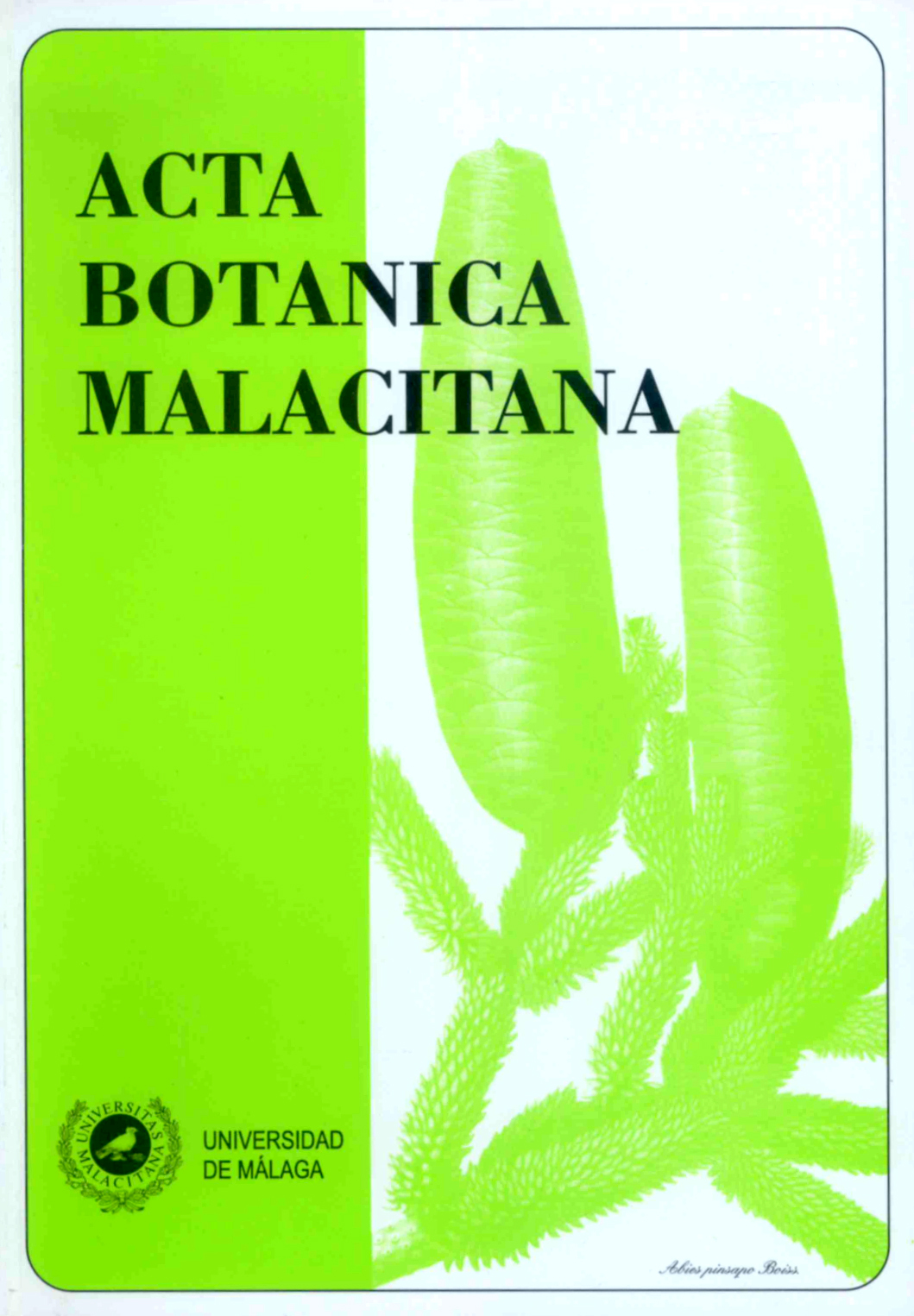Vegetación y flora de la Sierra de Cártama (Valle del Guadalhorce, Málaga, España). Vegetation and selected flora of Sierra de Cartama (Valle del Guadalhorce, Malaga, Spain)
DOI:
https://doi.org/10.24310/abm.v38i0.2628Resumen
Español. Se ha realizado un estudio florístico, fitocenológico y fitogeográfico de la Sierra de Cártama en su conjunto (Málaga, España). Bioclimáticamente, todo el territorio de estudio presenta piso termomediterráneo superior y ombrotipo seco inferior. Litológicamente, se presentan hasta 6 materiales diferentes, destacando un afloramiento de serpentinas. Se trata de una sierra pequeña pero muy diversa en cuanto a flora, puesto que se han detectado en torno a 579 taxones. Algunos de estos taxones han sido reseñados en este trabajo, por tratarse de nuevas citas para el área natural de la Axarquía, o por ser taxones de interés en función de su grado de amenaza, o de su distribución muy restringida en el territorio estudiado; entre ellos destaca el serpentinófito estricto Silene inaperta subsp. serpentinicola. Además, también se incluyen las especies alóctonas más destacables (17). Teniendo en cuenta la poca extensión del territorio de estudio (16000 Ha), ha sido elevada la cantidad de sintaxones detectados (44). El trabajo aporta el esquema sintaxonómico, y además los inventarios o tablas fitosociológicas de las asociaciones y comunidades de interés. Entre estos sintaxones, destacan: la asociación de los sectores Aljíbico y Malacitano-Axarquiense Biscutello baeticae-Anthoxanthetum ovati stat. nov., el pastizal nitrófilo y termófilo de Resedo albae-Chrysanthemetum coronarii cladanthetosum arabici subass. nova, los sabinares edafoxerófilos de Asparago horridi-Juniperetum turbinatae ceratonietosum siliquae subass. nova y el matorral sobre serpentinas de Lavandulo stoechadis-Genistetum equisetiformis thymetosum capitati var. con Avenula gervaisii subsp. gervaisii. Se han catalogado cuatro series de vegetación: una serie climátofila (Smilaco mauritanicae-Querceto rotundifoliae S) en sus faciaciones basófila y silicícola; dos series de vegetación edafoxerófilas (Asparago horridi-Junipereto turbinatae S y Pino pinastri-Querceto cocciferae S en su variante seca); y una serie de vegetación edafohigrófila (Rubo ulmifolii-Nerieto oleandri S). La vegetación de complejos edafogénicos se desarrolla en microhábitats rocosos umbríos (Asparago albi-Rhamnetum oleoidis var. de Vinca difformis y Celtis australis), manantiales tobáceos (Trachelio coeruleiAdiantetum capilli-veneris) y en hábitats con hidromorfía temporal (Ranunculo macrophylli-Juncetum inflexi, comunidad de Juncus bufonius y Centaurium pulchellum, Lythro juncei-Cyperetum fuscae).
English. Flora, vegetation and phytogeography have been studied in the Sierra de Cartama (Malaga, Spain). One bioclimatic belt and one ombrotype have been identified: upper thermomediterranean lower dry. The studied region shows six lithological types, considering relevant one outcrop of serpentine. Sierra de Cartama is a small mountain with a high amount of taxa (579). Some of this taxa have been highlighted in this work because they are new records for the area of Axarquia or they are interesting because they are threatened o their distribution is very restricted in the studied region; it is important the record for Silene inaperta subsp. serpentinicola, an obligate serpentinophyte. Moreover, alien species have been commented (17). The studied region shows a very high amount of syntaxa (44) if we take into account its small area (16000 Ha). This work includes a syntaxonomical scheme and relevés or tables for interesting or new phytosociological syntaxa. Some remarkable syntaxa have been pointed out: the graminoid grassland Biscutello baeticae-Anthoxanthetum ovati stat. nov., the anthropogenic thermophilic grassland Resedo albae-Chrysanthemetum coronarii cladanthetosum arabici subass. nova, the juniper community Asparago horridi-Juniperetum turbinatae ceratonietosum siliquae subass. nova and the serpentine shrubland Lavandulo stoechadis-Genistetum equisetiformis thymetosum capitati var. with Avenula gervaisii subsp. gervaisii. A total amount of 4 vegetation series have been catalogued: 1 series is climatophyllic (Smilaco mauritanicae-Querceto rotundifoliae S) developing in siliceous and calcareous soils, 2 edaphoxerophyllic series (Asparago horridi-Junipereto turbinatae S and Pino pinastri-Querceto cocciferae S, the latter in a dry variant); and 1 edaphohydrophyllic in riversides or soils with water tables (Rubo ulmifolii-Nerieto oleandri S). The vegetation that develops in mosaic-complexes corresponds to shaded rocky microhabitats (Asparago albi-Rhamnetum oleoidis var. de Vinca difformis and Celtis australis), calcareous springs (Trachelio coerulei-Adiantetum capilli-veneris) and inhabiting temporarily wet soils (Ranunculo macrophylli-Juncetum inflexi, community of Juncus bufonius and Centaurium pulchellum, Lythro juncei-Cyperetum fuscae).
Descargas
Métricas
Descargas
Publicado
Cómo citar
Número
Sección
Licencia
Toda la información relacionada con la licencia de uso de los trabajos publicados en Acta Botanica Malacitana y con los derechos de autor se pueden consultar en nuestra Política Editorial.








1.png)


